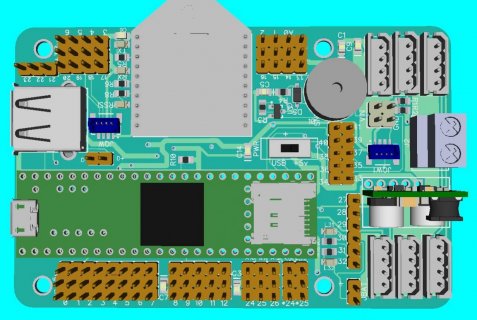KurtE
Senior Member+
Currently I am playing around with a few different board designs to play with the newer Lynxmotion Smart Servos(LSS) with a hexapod.
I am playing around with a few different options for boards using T4.1, one that is setup to simply have a Arduino Shield, which you can plug in their
shield (http://www.lynxmotion.com/p-1156-lynxmotion-smart-servo-lss-adapter-board.aspx)
The only interesting thing about this shield is there are 4 IO pins of interest, 2 that drive the servos, and 2 that communicate with an XBee and these either take in or output 5V... Also Their XBee pins don't match up with one of our UARTS. So on that board I setup to build in the equivalent of the Sparkfun bidirectional level converter using 4 BSS138 and 8 resistors... And I have a solder jumper that allows me to redirect one IO pin to another to align XBee with a hardware Serial port....
But over the last day or so, I have been playing around with an all in one Kitchen Sink board Which 3d looks like:
Which 3d looks like:

In this case I could get rid of the level converters for XBee as they are 3.3v...
I still have the second pair on the board, going to IO pins 24/25 to maybe drive Neopixels or Dotstars and or experiment with FlySky IBus receiver.
But the question I have is: for the LSS servos which are full duplex, probably with max Baud of 1000000 am I better off leaving the communications using the BSS138 Bidirectional setup on the TX/RX pins,
Or should I convert these two pins like:
RX pin - simple 2 resistor divider: like 1K and 2K?
TX pin - Maybe something like the transistor used on LC to up convert for neopixel? like 74LV1T125 transistor like: https://www.digikey.com/en/products/detail/texas-instruments/SN74LV1T125DBVR/4555571
(Or other like what is on PropShield?)
Again just having some fun!
I am playing around with a few different options for boards using T4.1, one that is setup to simply have a Arduino Shield, which you can plug in their
shield (http://www.lynxmotion.com/p-1156-lynxmotion-smart-servo-lss-adapter-board.aspx)
The only interesting thing about this shield is there are 4 IO pins of interest, 2 that drive the servos, and 2 that communicate with an XBee and these either take in or output 5V... Also Their XBee pins don't match up with one of our UARTS. So on that board I setup to build in the equivalent of the Sparkfun bidirectional level converter using 4 BSS138 and 8 resistors... And I have a solder jumper that allows me to redirect one IO pin to another to align XBee with a hardware Serial port....
But over the last day or so, I have been playing around with an all in one Kitchen Sink board

In this case I could get rid of the level converters for XBee as they are 3.3v...
I still have the second pair on the board, going to IO pins 24/25 to maybe drive Neopixels or Dotstars and or experiment with FlySky IBus receiver.
But the question I have is: for the LSS servos which are full duplex, probably with max Baud of 1000000 am I better off leaving the communications using the BSS138 Bidirectional setup on the TX/RX pins,
Or should I convert these two pins like:
RX pin - simple 2 resistor divider: like 1K and 2K?
TX pin - Maybe something like the transistor used on LC to up convert for neopixel? like 74LV1T125 transistor like: https://www.digikey.com/en/products/detail/texas-instruments/SN74LV1T125DBVR/4555571
(Or other like what is on PropShield?)
Again just having some fun!
Last edited:


